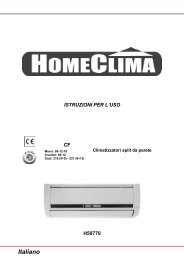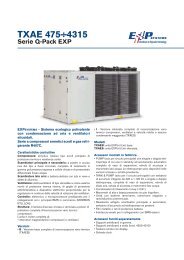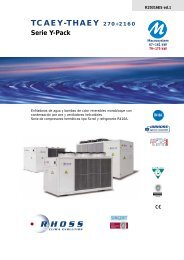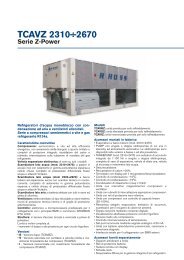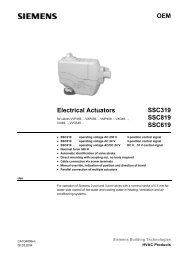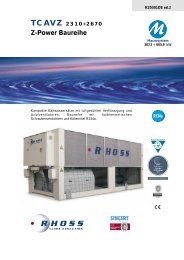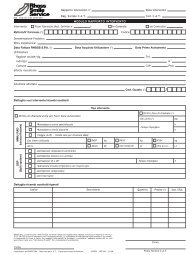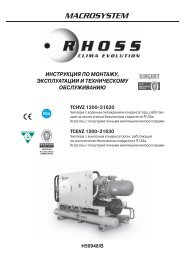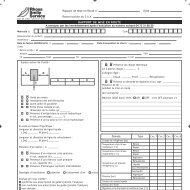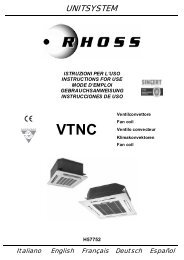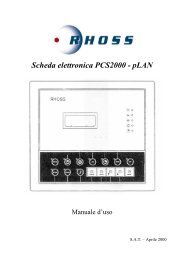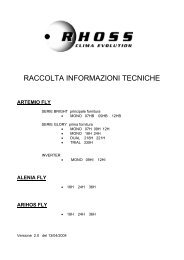SPLIT-SYSTEM - Rhoss
SPLIT-SYSTEM - Rhoss
SPLIT-SYSTEM - Rhoss
Create successful ePaper yourself
Turn your PDF publications into a flip-book with our unique Google optimized e-Paper software.
SECTION I: USER<br />
The remote control will not transmit the signal to the unit if a wall or any<br />
other object is in the way.<br />
Do not place any objects on top of the external unit.<br />
I.13 OPERATING ANOMALIES<br />
Symptom<br />
Recommended action<br />
The unit DOES NOT WORK (does not switch on)<br />
check whether the power supply is present (switch on a light)<br />
check that the air conditioning unit mains switch is on<br />
(if the switch is fitted with fuses, make sure that they are all intact)<br />
check whether the remote control works<br />
check whether the timer is inserted<br />
The unit works but does NOT COOL sufficiently<br />
Conditions that do not effect the normal operation of the air conditioning<br />
unit could occur, for example:<br />
• a rustling noise could be heard after the start-up or shutdown of the<br />
unit: this is due to the balancing of the gas pressure inside the<br />
refrigerant circuit;<br />
• temporary creaks could be heard if the air conditioning unit operates<br />
in low ambient temperature: this is due to the dilation of the panel<br />
caused by the temperature variation;<br />
• unpleasant smells could be smelt due to the accumulation of<br />
substances present in the air (cigarette smoke, cooking smells, etc.),<br />
especially if the rooms are not aired from time to time;<br />
• if the air conditioning unit operates continuously in cooling mode in<br />
an environment with a high level of relative humidity (over 80%),<br />
condensation could form on the deflector and on the fins of the internal<br />
unit, and this condensation could drip onto the floor and objects<br />
beneath;<br />
• in the heating mode (for heat pump models only), steam could come<br />
out of the external unit during the defrosting phase.<br />
check whether the cooling function is on<br />
check whether the temperature has been set on the remote control<br />
check whether the fan speed is too low<br />
check that there are no blockages in the internal and external unit air inlet<br />
or outlet<br />
check that the air filter is clean<br />
check that there are no doors or windows open<br />
check that there are no anomalous heat sources (iron, lots of people, etc.)<br />
I.14 INSTRUCTIONS FOR DISPOSAL OF THE UNIT<br />
AND HAZARDOUS SUBSTANCES<br />
SAFEGUARD THE ENVIRONMENT!<br />
RHOSS S.p.A. cares about protecting the<br />
environment.<br />
When the unit is dismantled it is important to<br />
adhere scrupulously to the following procedures.<br />
The unit should only be dismantled by a firm authorized for the disposal<br />
of scrap machinery/products. The unit as a whole is composed of<br />
materials considered as secondary raw materials and the following<br />
conditions must be observed:<br />
• the compressor oil must be removed, recovered and delivered to a<br />
body authorized to collect waste oil;<br />
• coolant gas must not be discharged into the atmosphere. It should<br />
instead be recovered by means of homologated devices, stored in<br />
suitable cylinders and delivered to a company authorised for the<br />
collection;<br />
• the filter-drier and electronic components (electrolytic condensers)<br />
are considered special waste, and must be delivered to a body<br />
authorized to collect such items;<br />
The expanded polyurethane pipe insulation must be removed and<br />
processed as urban-type waste.<br />
29



